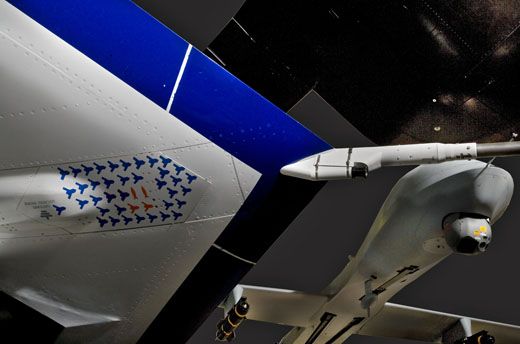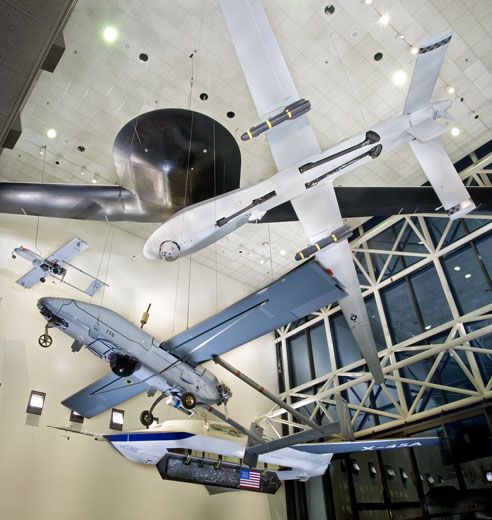In the Museum: Predators and Dragons
Stops on a tour through america’s hangar
/https://tf-cmsv2-smithsonianmag-media.s3.amazonaws.com/filer/AS_ITM_July2008.jpg)
Although Unmanned Aerial Vehicles are often touted as the future of air war, they’ve been around since 1917, when Ohio inventor Charles Kettering designed a flimsy unmanned biplane called the Liberty Eagle, better known as the Kettering Bug. Built on the cheap, the Bug was developed as a flying bomb, meant to carry explosives to targets 50 miles away. But the first world war ended before it could be used, and the Bug remained classified until World War II.
The first UAVs capable of returning after completing a mission were developed as the war in Vietnam began to escalate. That’s when radio-controlled drones evolved into reconnaissance vehicles, explains Dik Daso, a curator in the aeronautics division at the National Air and Space Museum, which has recently opened an exhibit dedicated to the type of airplane whose pilot stays on the ground.
“The star of the show is the Predator,” says Daso. “It was one of the first three airplanes that were authorized to deploy after [the terrorist attacks of] 9/11, and it might be one of the most significant combat airplanes we have in the collections” (see “Aircraft That Changed the World"). As significant as “Flak Bait,” the Martin
B-26B-25-MA that survived 207 combat sorties over Europe? That depends on how you define “significant,” but the Museum’s Predator was almost as busy. Built by General Atomics Aeronautical Systems, Inc., which sponsored the exhibit, the Predator flew nearly as many missions as “Flak Bait,” with 196 combat sorties in Afghanistan.
“The superstar weapon of Afghanistan and Iraq is a glider with an Austrian snowmobile engine, racing into combat at all of 70 miles per hour!” says James “Snake” Clark, director of Air Force Combat Support at the Pentagon and a former fighter pilot. “The Predator absolutely revolutionized warfare, and the one in the exhibition is the Elvis of Predators. It was the first rock-star Predator that we had. It was the first to deploy after 9/11, the first to test-fire a Hellfire missile, and the first to fire in combat in Afghanistan.”
But have pilots always been so enamored with UAVs?
“Would I have given up my F-16 to go fly a drone? No. But, that being said, flying a Predator is a little more challenging,” says Clark. “Once you put weapons on it, guys got really excited. Let’s say you were a former -130 pilot, a C-17 pilot, and now you’re shooting missiles at bad guys. Given a chance of an F-22 or an F-15, guys will always say they’d like to go to the real cockpit environment. But if you have to do a non-frontline flying job…the guys that are flying Predator are pretty happy. They know they’re popping bad guys and saving good guys, and that’s a lot of job satisfaction.”
In addition to the Predator, the exhibition features the equally famous RQ-2A Pioneer, which the U.S. Navy used to great effect during the 1991 Gulf War. Crew members aboard the USS Wisconsin launched the Pioneer toward Kuwait’s Faylaka Island to conduct bomb damage assessments after Iraqi defensive positions had been shelled. As the Pioneer swooped low over the island, a number of Iraqis waved makeshift white flags—the first soldiers to surrender in history to a UAV.
While the Navy has a long tradition of using remotely piloted helicopters, the Pioneer was its first fixed-wing UAV, and the aircraft was later used in contingency operations over Haiti and Somalia. Daso points out that the Pioneer’s Navy roots are clear. “It looks sort of like a Navy ship,” he says. “It’s got the gray, glossy paint, and if you get a little closer, you’ll see really big fasteners, really big rivets—they look just like the big bolts that hold the ships together.”
Two other combat veterans are also on display: the AeroVironment RQ-14A Dragon Eye, used by the U.S. Marine Corps, and the RQ-7A Shadow 200, which flew with the U.S. Army’s 4th Infantry Division, Stryker Brigade Combat Team number 2, and the 82nd Airborne Division.
Not all of the UAVs displayed at the Museum have seen battle; some are prototypes, such as Boeing’s X-45A, the first UAV designed as a combat aircraft. David Abel, the crew chief on the test project, describes the two prototypes (the other is on display at Wright-Patterson Air Force Base in Ohio) and their abilities: “The two aircraft would take off in tandem, go out to the predetermined test area, and a target would pop up on the ground. The two airplanes would communicate with each other and determine which was in the better position, which had weapons on board for the mission, and which had the fuel required to complete the mission, and that one would peel off and attack the target. They did it time and time again, and they did it very accurately.”
The best battlefield intelligence includes imagery from both UAVs and satellites, and the Lockheed Martin/Boeing RQ-3A DarkStar, designed with stealth in mind, was developed to linger undetected over enemy territory for hours at a time. “It’s the spookiest one,” says Daso of the saucer-shaped craft. The UAV never made it into production, however; after failures during flight testing, the Department of Defense terminated the program.
While the exhibit highlights the technological achievements of UAVs, Daso is quick to point out that the aircraft are only part of a complex system, and are incomplete without support personnel. “What’s so great about this exhibit,” he says, “is that you can educate kids and explain that you don’t have to be a pilot to fly these things—or design them.”

